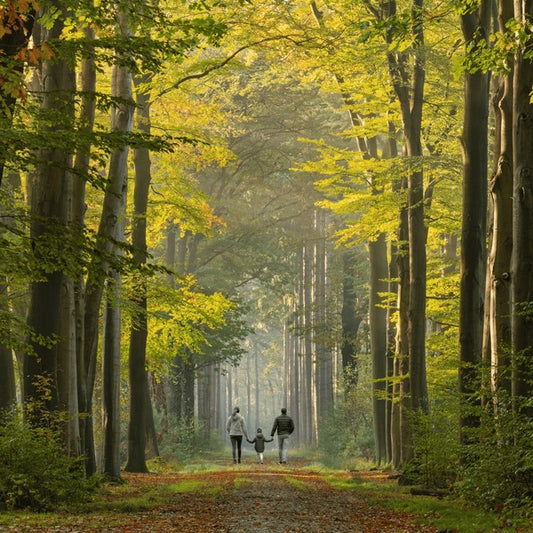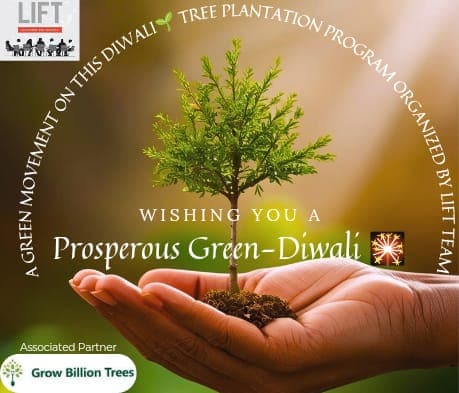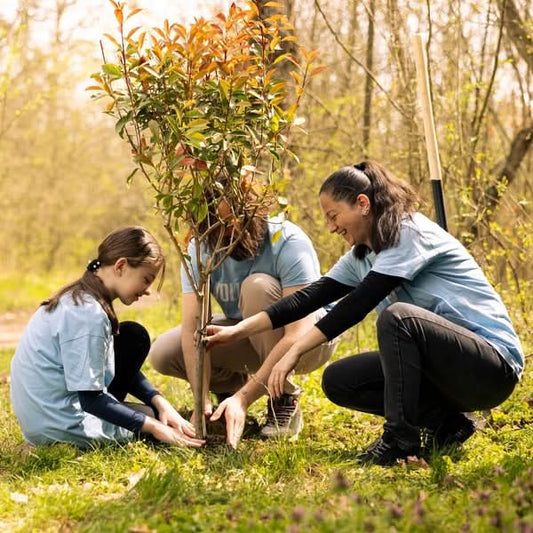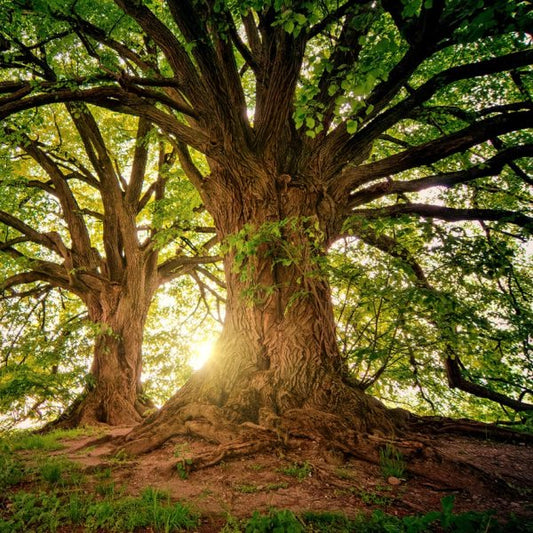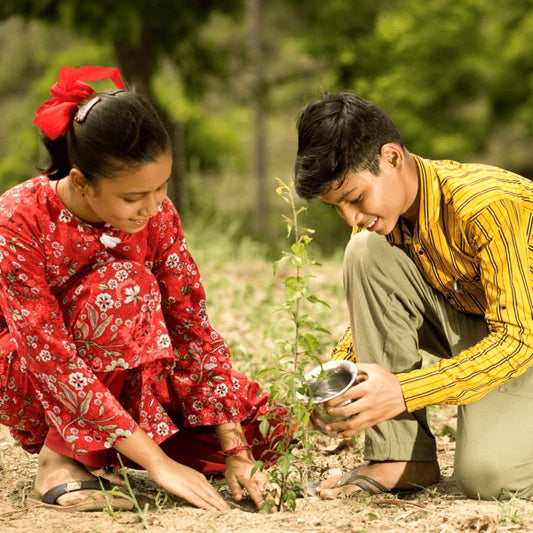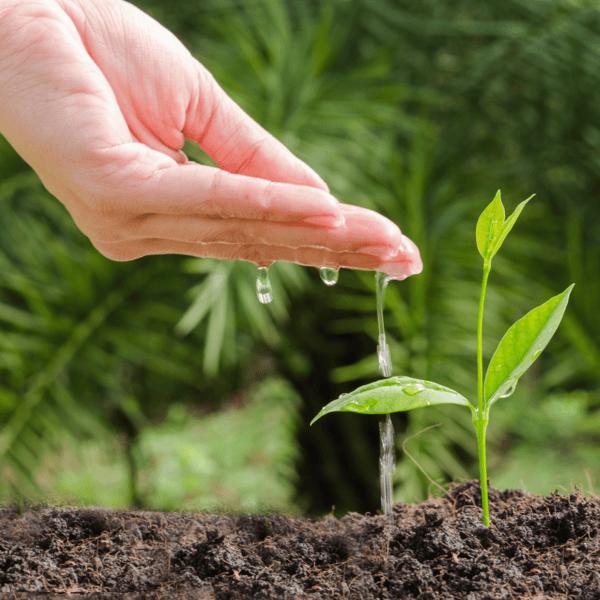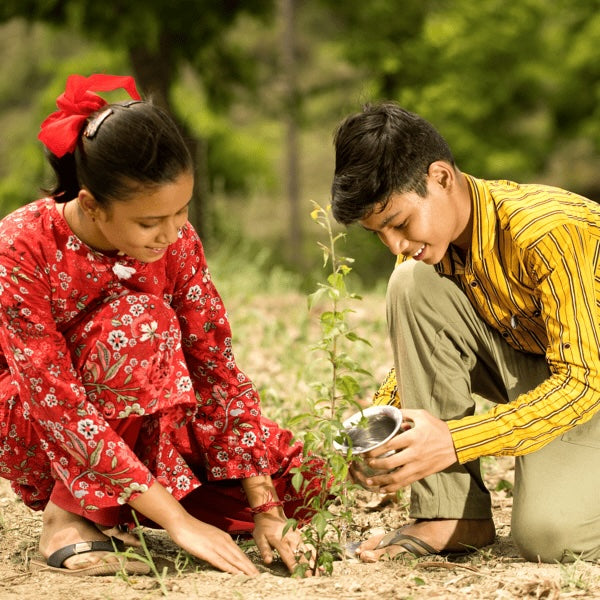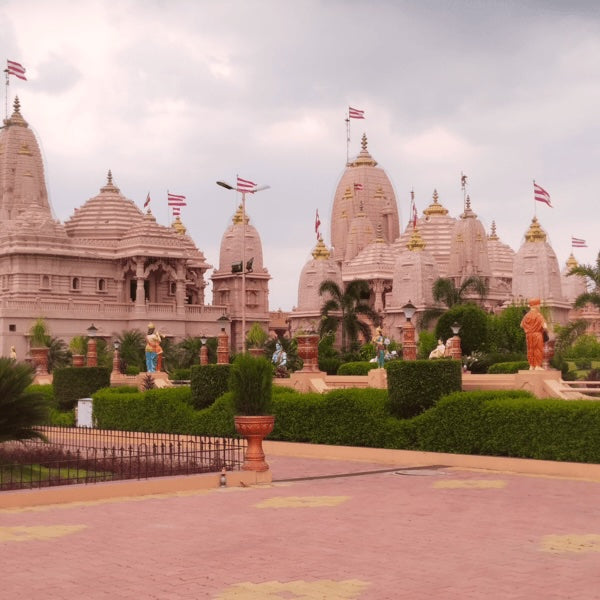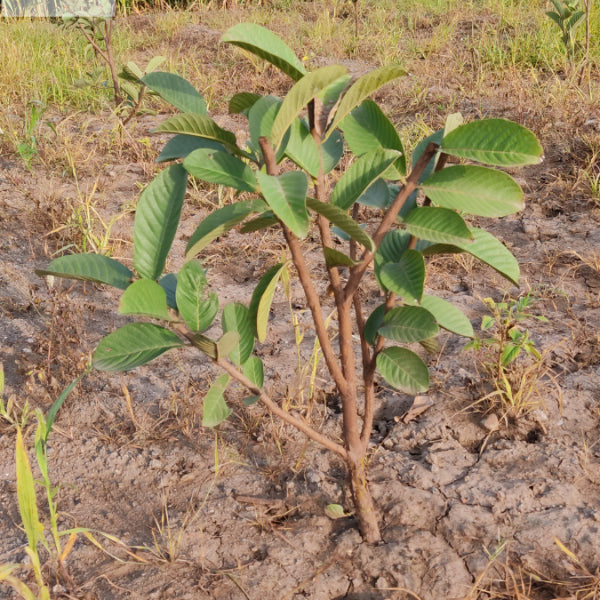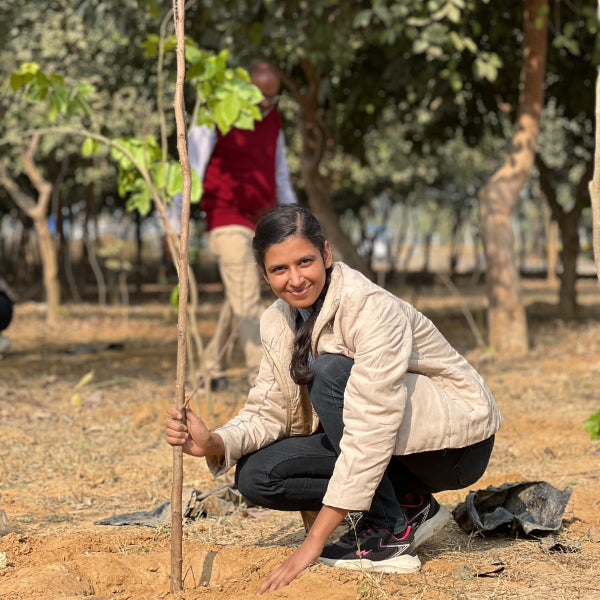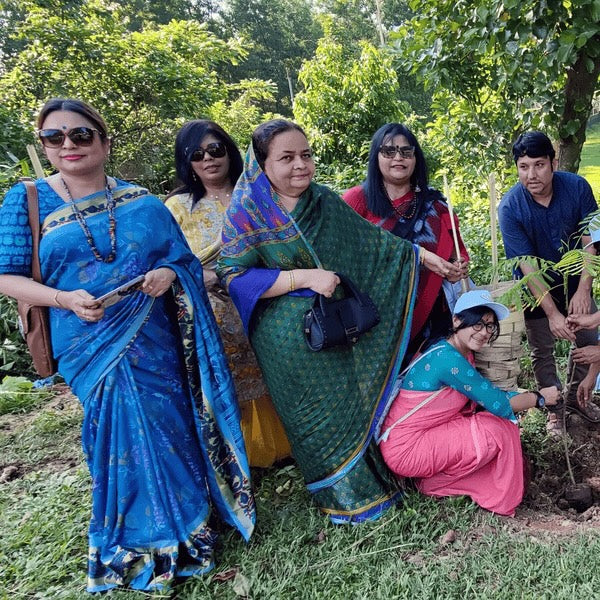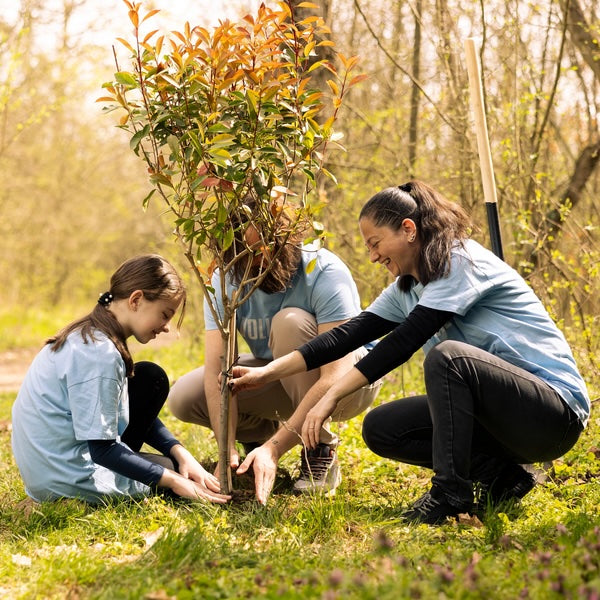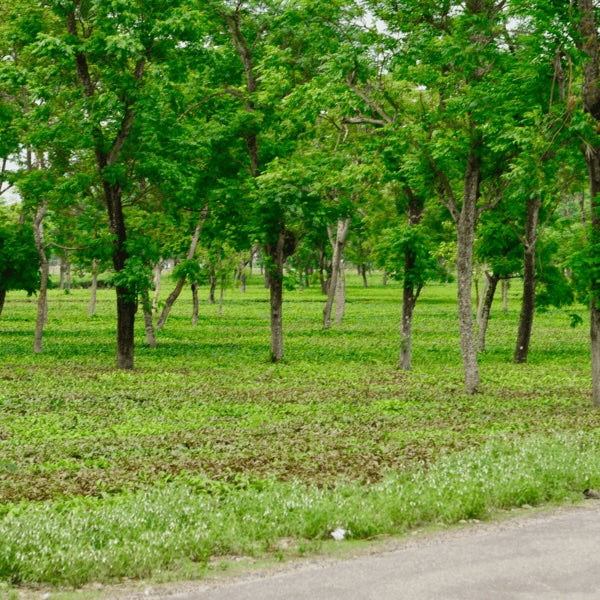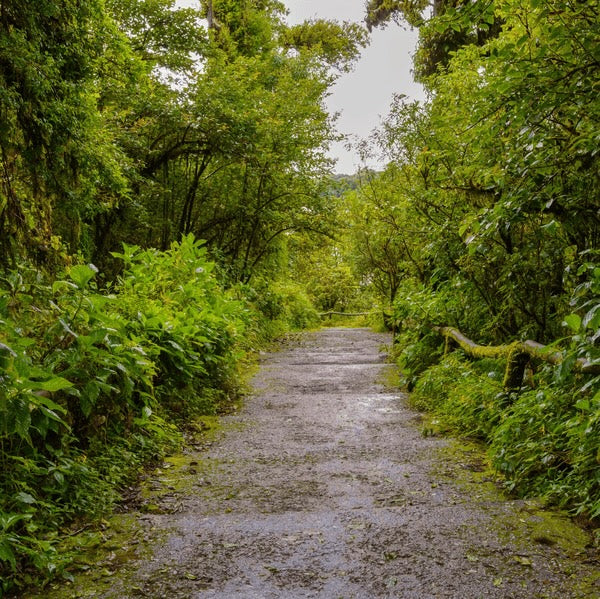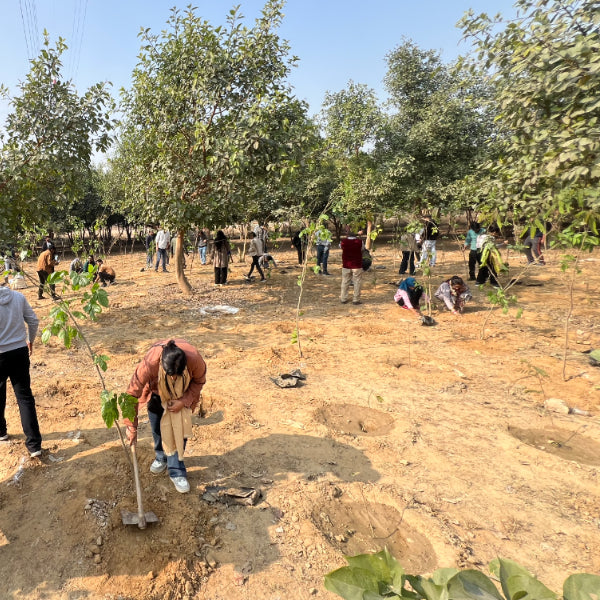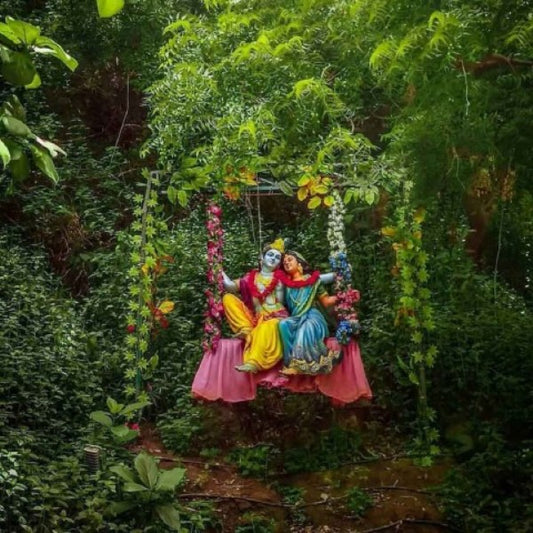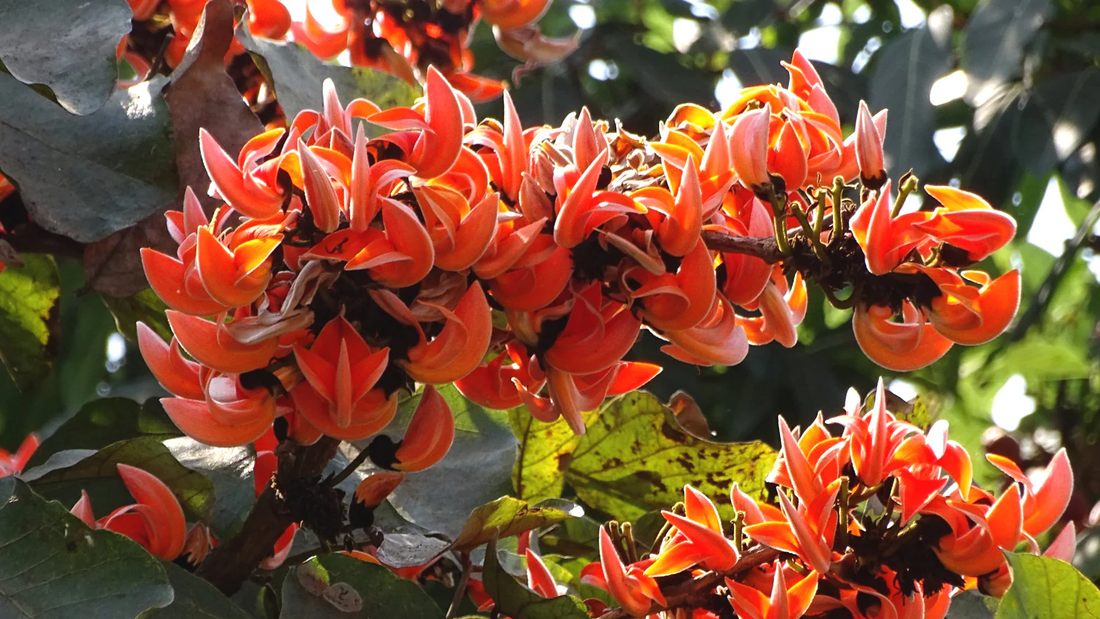

The Palash tree (Butea monosperma), often called the "Flame of the Forest," is more than a visual delight. Revered in mythology and sacred rituals, the tree finds mention in Vedic scriptures and epics. Blooming with fiery red-orange flowers, it conti Read more
Trending
Trees for Corporates
Palash Tree: The Fiery Blossom of Sacrifice and Strength
The Palash tree (Butea monosperma), often called the "Flame of the Forest," is more than a visual delight. Revered in mythology and sacred rituals, the tree finds mention in Vedic scriptures and epics. Blooming with fiery red-orange flowers, it continues to inspire pilgrimages and spiritual journeys across India. Let’s explore the cultural, mythological, and tourism dimensions of this sacred tree. 🔥🌳
1. Palash in Hindu Mythology and Vedic Rituals 🔱
The Palash tree is deeply embedded in Hindu mythology and is mentioned in the Rigveda as a sacred wood used in yajnas (sacrificial rituals). Its trifoliate leaves represent the Hindu trinity—Brahma, Vishnu, and Shiva—making it highly auspicious. Sages believed that no ritual was complete without Palash twigs, used as samidha (sacrificial fuel).
Why Tourists Visit: Many spiritual seekers visit ancient temple sites in Uttar Pradesh, Bihar, and Madhya Pradesh where Palash trees still grow around yajna shalas (ritual grounds). These locations provide a living link to Vedic rituals and sacred ecology.
How to Visit: Places like Kashi (Varanasi), Bodh Gaya, and Ujjain host Vedic cultural tours. These often include tree walks where priests and guides explain the role of trees like Palash in ancient rites. Many ashrams allow tourists to meditate under blooming Palash groves in spring (Feb–Mar).
2. Palash and the Festival of Holika Dahan 🌸🔥
Legend says that the vibrant red of the Palash flower symbolizes the fire of Holika Dahan, the night before Holi. In some parts of India, especially in Jharkhand and Chhattisgarh, the flowers are used to create natural colors for the Holi festival, reviving an eco-friendly tradition rooted in mythology and seasonal rhythm.
Why Tourists Visit: Cultural tourists and eco-enthusiasts travel to tribal regions like Ranchi and Bastar to witness the colorful Holi made from Palash blooms. These experiences blend tribal folklore, dance, and plant-based traditions.
How to Visit: Eco-tour operators and local NGOs organize spring cultural tours. Visitors often participate in flower collection, learn natural dye-making, and attend Holika Dahan ceremonies around ancient Palash trees.
3. Palash in Buddhist and Jain Lore ☸️
In Buddhist texts, the Palash tree is linked to enlightenment and was considered sacred in forest monasteries. Jain monks used its wood for ascetic rituals due to its purity. Some believe the last sermon of a Jain Tirthankara was given beneath a blooming Palash tree in ancient Rajgir.
Why Tourists Visit: Pilgrims visit ancient Buddhist and Jain sites like Sanchi, Rajgir, and Vaishali, where Palash trees are part of spiritual landscaping. Tourists engage in mindful walks and tree meditations under the flame-colored canopy.
How to Visit: Most of these destinations are part of the Buddhist circuit in Bihar and Madhya Pradesh. Cultural and heritage guides offer tree-trail experiences, and spring is the best time to witness the tree in full bloom.
4. Sacred Groves and Tribal Worship 🌾🛕
In many tribal cultures of Odisha, Chhattisgarh, and Maharashtra, the Palash tree is worshipped as a guardian spirit. Tribes like the Gonds and Santhals consider it the abode of local deities and conduct full-moon rituals under its branches.
Why Tourists Visit: Offbeat travelers and anthropologists visit sacred groves where tribal communities preserve Palash trees and their folklore. Festivals like Sarja Parab are timed with Palash blooms and attract curious tourists.
How to Visit: Through tribal tourism programs, visitors are guided to sacred groves and traditional ceremonies. Local homestays often provide cultural immersion during blooming season.
5. Forests Ablaze: The Spring Bloom Experience 🌺
In March, forests in states like Jharkhand, Odisha, and Telangana appear as if they’re on fire—thanks to Palash flowers. These regions organize nature festivals and hikes under the flaming canopy, drawing nature photographers and wildlife lovers.
Why Tourists Visit: For the stunning natural visuals, birdwatching, and rare photography opportunities. The bloom also coincides with regional folklore festivals and local art fairs inspired by the Palash flower.
How to Visit: Nature trails in Simlipal National Park and Kanger Valley offer guided hikes with forest rangers. Local communities serve Palash-infused herbal drinks and offer folklore sessions under the trees.
Conclusion 🌿
The Palash tree is a beacon of spiritual, mythological, and ecological wonder. It invites not just admiration, but exploration. From Vedic yajnas to tribal folklore and spring festivals, this sacred tree draws tourists into stories etched in bark and bloom. If you’re planning your next spiritual or cultural getaway—follow the flame of the forest. 🔥🌳
You may also like
Corporate Plantations
Palash Tree Mythology
The Palash Tree isn’t just flora; it’s a fiery character in ancient Indian myths. Linked to tales of sacrifice and spiritual strength, it’s said sages performed yagnas under its flaming canopy. Hindu scriptures even call it Brahma’s favorite tree! This legend-rich tree is basically the OG influencer of the forest—wise, old, and always on fire (literally, with those red blooms). If mythology had a red carpet, the Palash would be strutting down it, petals blazing, with the gods cheering from the sidelines.
Flame of the Forest
Known by this poetic alias, the Palash Tree sets landscapes ablaze with its scarlet-orange blooms. Not actual fire, mind you—just nature showing off its color palette. When the dry season hits and everything else wilts, the Palash decides it’s showtime. It’s the tree version of a mic drop—fiery, unapologetic, and impossible to ignore. If your Instagram feed had a botanical diva, this would be it. No filters needed, just petals.
Palash Tree in Ayurveda
Who knew the tree that looks like it’s on fire is actually a healer in disguise? Palash has been flexing its medicinal muscles for centuries in Ayurveda. From treating worms to boosting skin health, this tree’s parts are like an all-natural first-aid kit. The bark, leaves, and flowers aren’t just pretty—they mean serious herbal business. Think of it as the ancient Indian pharmacy with petals. Modern medicine, meet your sassy, petal-powered cousin.
Palash Tree Flowers
These aren’t just pretty faces. Palash flowers bloom in bold reds and oranges, like tiny flames flirting with the breeze. They're so iconic, they’re used in Holi powders and even as natural dye. And when they fall? It’s like the forest got a confetti cannon. These blooms aren’t just seasonal eye candy—they’re eco-friendly, Insta-worthy, and basically the tree’s way of saying, “Look at me now!”
Cultural Significance of Palash
In Indian traditions, the Palash isn’t just admired—it’s revered. Used in rituals, festivals, and poetry, this tree is a cultural celeb. It shows up in Puranas, folk songs, and even love tales. Palash leaves double as eco-friendly plates, and flowers become Holi’s natural color bombs. Basically, it’s the tree that RSVPs to every Indian occasion and steals the spotlight. Talk about rooted in culture—with flair.
Palash Tree and Holi
Forget synthetic colors—real Holi pros know the best reds come from Palash flowers. These petals don’t just party; they protect your skin while doing it. Boil them up and boom—organic color that smells like spring and feels like tradition. The tree literally blooms just in time for the festival, like it got the memo. Mother Nature’s own event planner? The Palash is it.
Butea Monosperma
That’s the Palash Tree’s scientific stage name. Sounds like a fancy cocktail, right? But this isn’t just Latin for fun—it’s your keyword ticket to impress Google and botanists alike. This fiery flora belongs to the Fabaceae family and flaunts its monosperma seed like it's a VIP pass to the biodiversity club. When you drop “Butea Monosperma” into your content, you’re basically SEO name-dropping a botanical celebrity.
Palash Tree Leaves
While the flowers hog the limelight, the leaves are low-key multitaskers. Used for traditional thalis (plates) and even in sacred rituals, these leaves are the green sidekicks with real utility. They're tough, eco-friendly, and slightly rebellious—refusing to rot quickly, even in compost. So while everyone’s busy praising the blooms, the leaves are out here being practical, sustainable legends.
Palash Tree Habitat
The Palash isn’t picky—it thrives in dry deciduous forests, scrublands, and even open grasslands. You’ll find it blazing away across central and northern India like a floral wildfire. It's the tree that doesn’t need perfect soil or pampering, just a bit of sunshine and space to flaunt. Think of it as the tough beauty that blooms where others barely survive—resilient, radiant, and rooted in grit.
Ecological Role of Palash
The Palash doesn’t just look good—it works hard. Bees, birds, and butterflies? All RSVP to its seasonal flower fest. It helps prevent soil erosion, improves fertility, and adds vibrant energy to ecosystems. It’s like that friend who’s always throwing the best parties and helping you clean up afterward. Stylish and sustainable—the Palash is nature’s overachiever in a fiery dress.
Palash Tree Symbolism
The Palash stands for sacrifice, purity, and strength—basically the forest’s philosopher-king. It’s said to symbolize warrior spirit and unwavering resilience, blooming in harsh summers like it’s no big deal. Want to inspire courage or channel sacred energy? The Palash has the vibe. It’s not just a tree—it’s a leafy life coach with a crown of flame.
Palash Tree Tourism
Want to chase fire without getting burned? Head to places like Jharkhand, Chhattisgarh, or Madhya Pradesh in peak bloom season and witness nature’s own color festival. Forests turn into glowing canvases of red-orange magic, and eco-tourism gets a petal-powered boost. Forget tulip gardens—India’s got the Palash trail, where every turn looks like it was painted by a fire-tipped brush.
FAQ
What is the Palash tree and why is it called the "Fiery Blossom of Sacrifice and Strength"?
The Palash tree, known for its blazing orange-red blooms, is more than eye candy—it’s rooted in Indian folklore as a symbol of valor and purity. It’s called the “Fiery Blossom” because it flourishes in drought, standing strong while others wilt. Now that’s what we call blooming with bravery!
Where is the Palash tree commonly found in India?
From the plains of Madhya Pradesh to the edges of Jharkhand and Chhattisgarh, the Palash tree proudly paints India’s dry forests in fire. It thrives where few others dare, making it a botanical rebel with roots. So if you’re in central India during spring, keep your eyes peeled for the red riot!
Is the Palash tree sacred in Indian culture?
Myth has it the tree grew from Lord Shiva’s sweat during battle. So yes, it’s sacred, stylish, and spiritually stacked.
Why is the Palash tree associated with sacrifice and strength?
Because it thrives in tough soil and harsh climates, it’s a living metaphor for resilience. Its flowers are used in rituals symbolizing purity and sacrifice. If trees had superhero capes, Palash would rock one with fiery flair—standing tall even when the going gets gritty.
What are the benefits of the Palash tree?
From healing wounds to dyeing fabrics, the Palash tree does it all. Its bark, flowers, and seeds are used in Ayurveda, plus it attracts pollinators like bees. Who knew this floral flame was also a multitasking eco-warrior
Can I grow a Palash tree in my garden?
”
What’s the flowering season of the Palash tree?
Doesn’t matter. These flowers make their own rules.
Is the Palash tree good for biodiversity?
Oh, totally. Birds, bees, and butterflies are big fans. The tree’s nectar-rich flowers are a five-star buffet for pollinators. Plus, its shade and structure support small mammals and insects. Basically, it’s a botanical Airbnb with excellent guest reviews.
Why is the Palash flower used during Holi?
Go old-school with Palash petals.
Does the Palash tree have any mythological stories?
Yes—and they’re epic. Legend says Brahma used a Palash twig in sacred rituals, and sages preferred it for yajnas. Some say it grew from drops of divine blood. Either way, this tree’s got a backstory worthy of a Netflix series.
Is the Palash tree used in Ayurveda?
Oh yes, it’s like the multi-vitamin of trees. Bark for ulcers, seeds for worms, flowers for skin. The Palash tree’s been fixing things since way before pharmacies existed. It’s ancient, it’s effective, and it smells better than your medicine cabinet.
What makes the Palash tree unique among Indian natives?
Still fabulous. Palash stands apart with fire-colored blooms, spiritual legacy, and eco-benefits galore. Among Indian native trees, it’s the fiery fashionista with a heart of gold.
Most Popular
Connect with us
-
👥 Corporates
If you are looking for:
- 🌲 Tree Plantation Events
- 📊 CSR Projects
📧 corporate@growbilliontrees.com
📞 +91 9699723523
💬 +91 9325931304 WhatsApp (Only)
🕒 Mon - Sat | 10am - 7pm IST
-
🧩 Tree Plantation NGOs
If you are looking for:
- 💰 Financial Assistance
- 🤝 Operational Support
📧 support@growbilliontrees.com
📞 +91 9699723523
💬 +91 9325931304 WhatsApp (Only)
🕒 Mon - Sat | 10am - 7pm IST
-
🌼 Individuals
If you are looking for:
- 👥 Group Tree Plantation Drive
- 🌳 Bulk Tree Plantation
📞 +91 9699723523
💬 +91 9325931304 WhatsApp (Only)
🕒 Mon - Sat | 10am - 7pm IST




